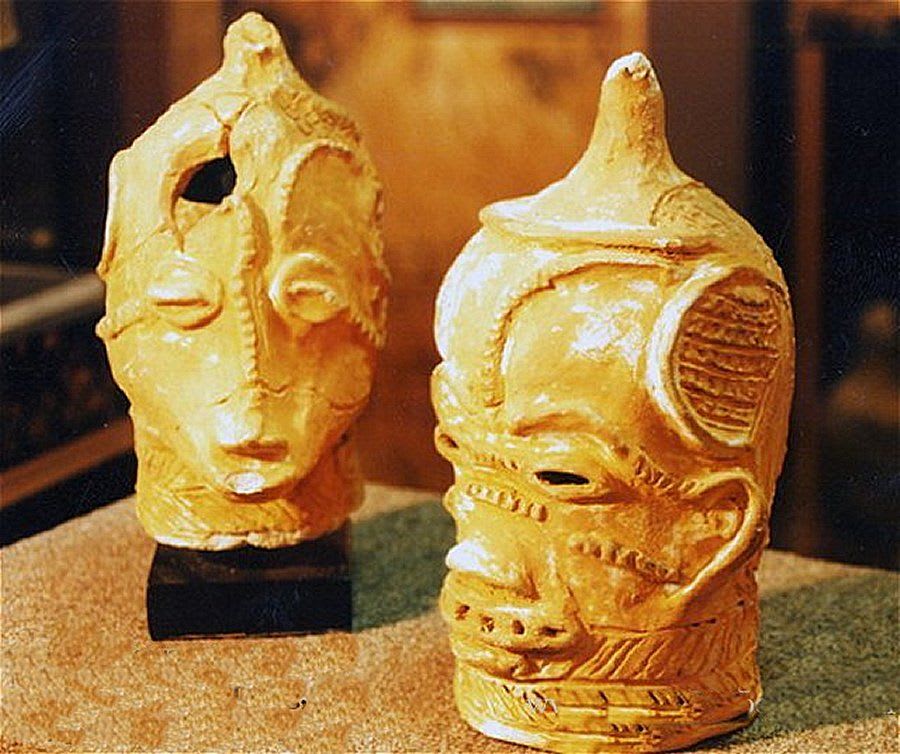Between 1962 and 1964, a young boy discovered strange pieces of pottery eroding out of a gully in Lydenburg, Mpumalanga, South-Africa. Although the fragments were not formally excavated, most pieces were found and re-constructed to make-up seven heads – collectively called the Lydenburg Heads. They are to date the earliest known examples of Iron Age art south of the equator.
The heads, initially broken into numerous pieces, were collected from the surface of the site by Dr. K. L. von Bezing in the early 1960s. He took them to the University of Cape Town, where work on their reconstruction began. They are currently on exhibition at the South African museum in Cape Town. They are believed to date back to 500AD and were used for ceremonial purposes by early Iron Age inhabitants.
The Iron Age was a period in human history that started between 1200BC and 600BC, following the Stone Age and Bronze Age. During the Iron Age, people across much of Europe, Asia and parts of Africa began making tools and weapons from iron and steel. For some societies, including Ancient Greece, the start of the Iron Age was accompanied by a period of cultural decline. Archaeologists believe that there may have been a period of famine in which Greece’s population dropped dramatically and major cities were abandoned. People shifted to smaller, more pastoral groups focused on raising livestock.
After reconstruction, the Lydenburg fragments revealed seven heads – two large and five smaller ones. The more complete of the larger heads has been reconstructed and entirely restored by the conservation laboratory of the British museum. Four of the smaller heads show close resemblance to each other both in scale and in design detail, all seven have a number of common attributes that justify their description as a group.
The texture of the fired earthenware is coarse and porous, and its coloring ranges from red to golden orange. Smooth areas on the faces show clear signs of burnishing, and on all seven artefacts there are traces of glittering stones on the carved pieces, these stones can also be found on the eyebrows as well as on the bar across the forehead.
The heads are hollow and they are roughly an inverted U in shape. Each, however, has been specially formed to receive the addition of modeled facial areas, while neck areas are delineated with bold incision. The bigger heads also have studs set in irregular bands behind the ridge defining the forehead and temples.
The masks have both human and animal-like features - characteristics which may explain their symbolic use during initiation and other religious ceremonies. Animals are a common motif in African mask making. They represent the spirit of an animal and the individual that wears the mask, becomes that animal himself, which allows for communication with that animal, for instance, to ask the animal to keep away from the village. In other cases, the animal is a symbol of virtue. The most common animals that are represented with masks are buffalo, hyena, hawk, crocodile, and antelope. Antelope is one of the most widely used animal masks, additionally, a small unidentifiable animal sits atop one of the Lydenburg heads.
Carbon dating has proved that the heads date to approximately 490AD and were made by Early Iron Age people. These people were Bantu herders and agriculturalists, and probably populated Southern Africa from areas north-east of the Limpopo River. Similar ceramics were later found in the Gustav Klingbiel Nature Reserve and researchers believe that they are related to the ceramic wares (pottery) of the Lydenburg Heads site, because of their form, function and decorative appeal. This sequence of pottery is formally known as Klingbiel type pottery. Speculation surrounding the Lydenburg Heads is that they have been created to serve aesthetic and / or ceremonial purposes including initiation rights. The five smaller heads have holes in their sides, which some archaeologists suggest may have been used to connect them to something at their time of use either a pole or a costume during a performance.
According to Professor Simon Hall, archaeology professor at the University of Cape Town, it was established that the masks were created and used by Bantu speakers. Bantu speakers were mixed farmers who lived in settled villages and were extremely accomplished metallurgists and potters. This was confirmed by the fact that the Lydenburg heads are ceramics/pots that were sculpted to look like human heads. When asked who the likely makers were (in terms of gender), Professor Hall said -“they were most likely made by Bantu women, based on what anthropologists call the division of labour in Bantu language societies. Pottery was considered women’s work while metallurgy, which is the transformation of ore to metal, was a male’s job.”
There has been some speculation that some of the heads are made of human skulls, but this has been proven false due to anthropological and archaeological evidence. According to Professor Simon none of the Lydenburg heads were human, neither is there any evidence to this effect. “… the heads were discovered in several broken pieces of ceramic that were excavated and later assembled. There were no human remains present, much speculation has been done on the possible uses of the masks based on the decorations and size.”
Leave a Comment
Sign in or become a Africa Rebirth. Unearthing Africa’s Past. Empowering Its Future member to join the conversation.
Just enter your email below to get a log in link.


Related News
Congo’s Unfinished Revolution: Patrice Lumumba and the Struggle for Sovereignty
Jun 01, 2025
When Oil Was Worth More Than Lives: Britain’s Role in the Biafran War
May 31, 2025
How Mozambique Broke Free from 500 Years of Portuguese Rule
May 30, 2025